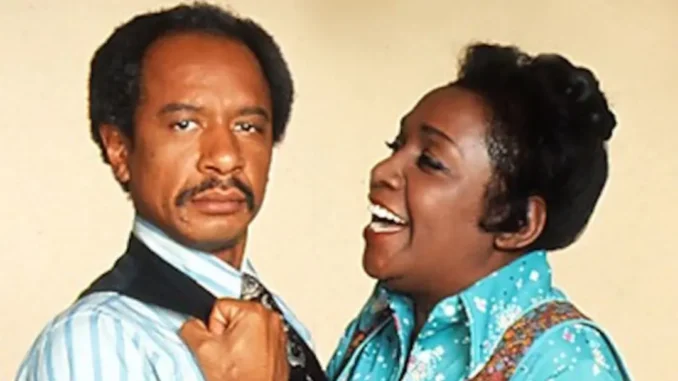
The Jeffersons: Unveiling the Legacy of One of TV’s Most Iconic Shows
Spanning 253 episodes from 1975 to 1985, The Jeffersons stands out as one of television’s most influential and beloved sitcoms. Created by Don Nicholl, Michael Ross, and Bernie West, and developed by the legendary Norman Lear, the show depicted the life of a wealthy Black family living in a luxurious high-rise apartment on New York’s Upper East Side. Following the success of Lear’s previous hit, All in the Family, The Jeffersons became a groundbreaking series, shedding light on issues of race, class, and social mobility.
The Birth of The Jeffersons
The Jeffersons was a spinoff of All in the Family, where George (Sherman Hemsley) and Louise “Weezy” Jefferson (Isabel Sanford) first appeared as neighbors of Archie and Edith Bunker. While Archie’s bigoted remarks were often directed at the Jeffersons, George’s success as a businessman allowed him and his wife to move from their modest home in Queens to a “deluxe apartment in the sky” in Manhattan. This transition marked the beginning of the show, which portrayed their new life and the challenges they faced.
The show was part of a golden era for sitcoms centered on Black families, with concurrent hits like What’s Happening!! also on the air. The Jeffersons stood out for its unique approach to comedy and social commentary, becoming one of the most successful spinoffs from All in the Family. While Maude (featuring Bea Arthur) and Archie Bunker’s Place were also spinoffs, none reached the level of success that The Jeffersons did.
Behind the Scenes: Mike Evans and the Cast Dynamics
Mike Evans, who played Lionel Jefferson, was initially a key figure in The Jeffersons and later co-created Good Times. However, his involvement was not without conflict. Evans felt he deserved more screen time and threatened to leave the show if his demands were not met. Lear, unfazed by the ultimatum, allowed Evans to leave. Damon Evans, no relation, briefly took over the role until Mike Evans returned in 1979. This behind-the-scenes drama is a testament to the complex dynamics that shaped the show.
Sherman Hemsley and Isabel Sanford: A Perfect Match
Sherman Hemsley and Isabel Sanford, who portrayed George and Weezy Jefferson, had impressive theater backgrounds before joining The Jeffersons. Sanford, who was 21 years older than Hemsley, had worked as a data processor before making her mark on Broadway and in the film Guess Who’s Coming to Dinner? Hemsley, originally a post office clerk, began his acting career with The Negro Ensemble Company and made his Broadway debut in Purlie. Despite their age difference, their on-screen chemistry as a married couple was both believable and beloved by audiences.
Breaking Barriers: Representation and Inclusivity
When The Jeffersons premiered, the idea of an interracial couple was still relatively taboo on television. The show included Helen and Tom Willis, played by Roxie Roker and Franklin Cover, who were depicted as an interracial couple living in the Jeffersons’ building. Initially, George Jefferson’s reaction to the Willises was dismissive and racially insensitive, but over time, his relationship with Tom Willis evolved into genuine friendship. This portrayal of interracial relationships was groundbreaking and reflective of the shifting social attitudes of the time.
Norman Lear’s commitment to representation extended beyond race. In a notable episode from Season 4, The Jeffersons featured Edie, a transgender character played by Veronica Redd. This episode, titled “Once a Friend,” was significant as it presented one of the first transgender characters on American television. While the portrayal was not without its limitations—George’s initial reaction was marked by transphobic remarks—the inclusion of Edie was a pioneering step in mainstream media.
Controversies and Legal Battles
The success of The Jeffersons was not without its controversies. Eric Monte, who co-created Good Times, sued Norman Lear, alleging that Lear had stolen ideas for The Jeffersons and other shows. Monte claimed that Lear was comfortable depicting Black Americans in stereotypical ways and was resistant to certain aspects of his creative vision. Although Monte was offered a settlement, he claimed that his career suffered as a result of these disputes.
The Legacy of The Jeffersons
Despite the controversies, The Jeffersons left an indelible mark on television. The show tackled issues of race, class, and social mobility with humor and heart, breaking new ground in its portrayal of Black families and interracial relationships. The theme song, “Movin’ On Up,” co-written by Ja’Net DuBois, became an iconic anthem that encapsulated the show’s themes of upward mobility and success.
Even years after its finale, The Jeffersons continues to be celebrated for its contributions to television and its role in advancing social issues. The show’s blend of comedy and social commentary remains a benchmark for fut
ure television series, making it a lasting part of TV history.
In Conclusion
The Jeffersons remains a testament to the power of television to reflect and influence societal attitudes. Its pioneering portrayal of a successful Black family and its exploration of social issues have left a lasting impact on viewers and the industry. Through its memorable characters, groundbreaking storylines, and iconic theme song, The Jeffersons continues to be celebrated as one of television’s greatest achievements.
